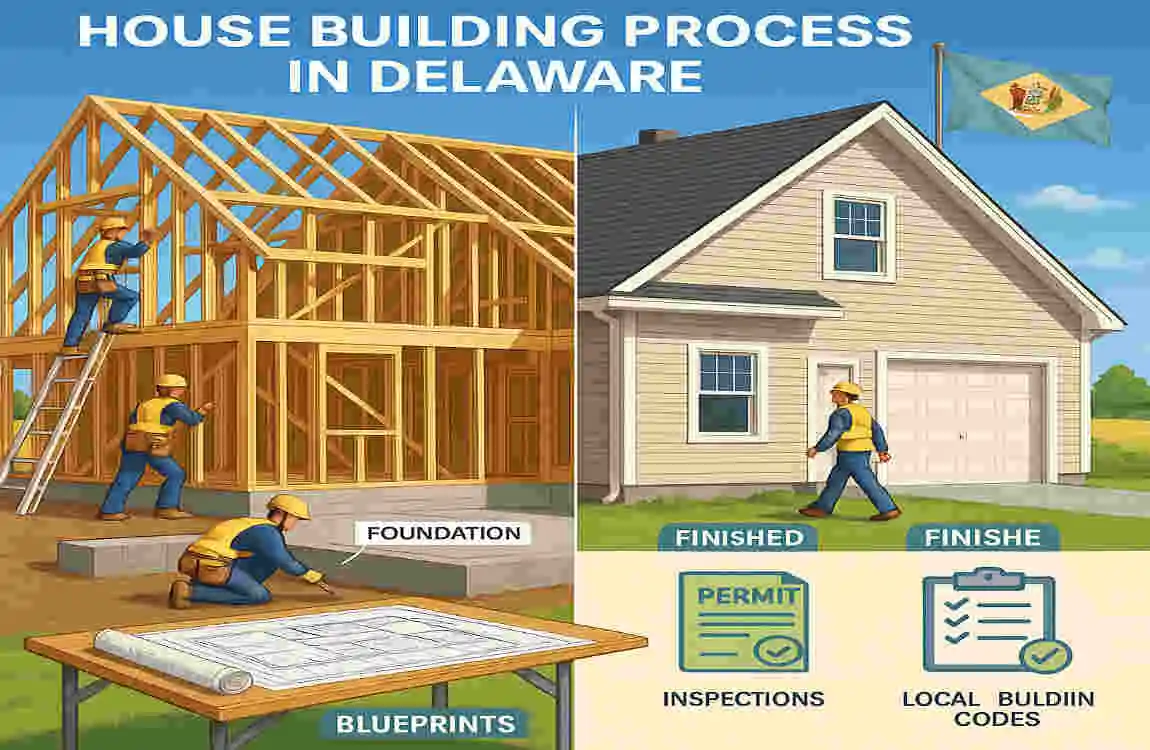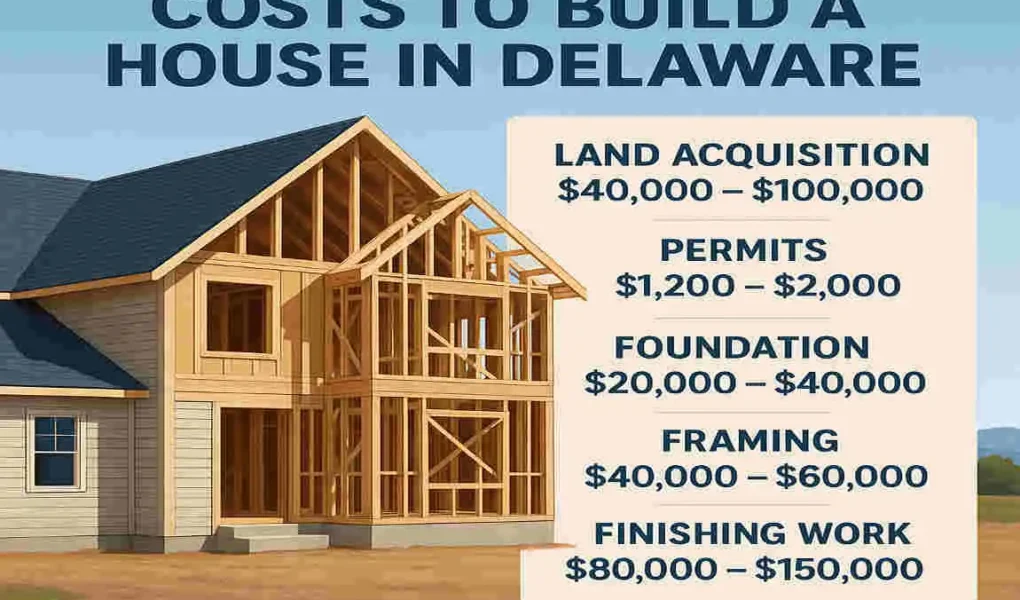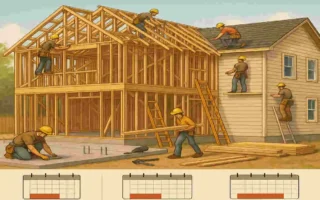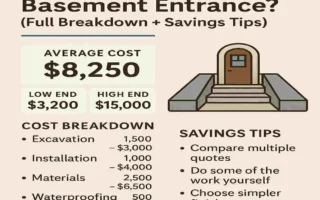Building your dream home in Delaware is an exciting journey, but let’s face it – the financial planning can feel overwhelming. With construction costs climbing higher each year and Delaware’s unique market conditions, knowing exactly how much to budget has become more crucial than ever.
If you’re wondering how much it costs to build a house in Delaware, you’re not alone. Thousands of potential homeowners grapple with this question every year. The good news? With proper planning and realistic expectations, building home can still be a wise financial decision.
Overview of Building a House in Delaware

Building a house involves multiple stages, each with its own timeline and costs. The process typically starts with land purchase and site preparation. Next comes the foundation work, followed by framing, roofing, and exterior finishing. Interior work includes plumbing, electrical, HVAC installation, insulation, drywall, and final finishes.
The entire journey from breaking ground to moving in usually takes 6 to 12 months. Weather conditions, permit approvals, and material availability can all affect your timeline. Delaware’s relatively mild climate means construction can continue through most of the year, though winter months may slow exterior work.
Benefits of Building vs. Buying
Building offers several advantages over purchasing an existing home in Delaware. You get complete customization control – from floor plans to fixtures, every detail reflects your preferences. New construction also means adhering to modern energy efficiency standards, which can potentially save thousands in utility costs over time.
Brand-new homes come with warranties on construction and appliances. You won’t inherit someone else’s maintenance problems or outdated systems. Plus, you can incorporate smart home technology and sustainable features from the start.
However, building requires more time and involvement than buying. You’ll make countless decisions and manage various contractors. The upfront costs can be higher, though long-term value often compensates for this initial investment.
Average Cost to Build a House in Delaware in 2025
Let’s address the big question: how much does it cost to build a house in Delaware? Current estimates range from $270,000 to $550,000 for average-sized homes. These figures reflect standard construction quality and typical amenities.
The cost per square foot currently averages around $170 in Delaware. This means a 2,000 square foot home would cost approximately $340,000 to build. A larger 3,000 square foot home pushes the budget to around $510,000. Remember, these are baseline figures – your actual costs depend on numerous factors.
How Home Size Affects Your Budget
Smaller homes offer better cost efficiency per square foot. A 1,500 square foot starter home might cost $255,000 total, or $170 per square foot. Meanwhile, a spacious 4,000 square foot home could reach $680,000, maintaining that same per-square-foot average.
The homebuilding cost Delaware residents face varies significantly based on design complexity. Simple rectangular layouts cost less than homes with multiple angles, bay windows, or complex rooflines. Each additional bathroom adds $15,000 to $25,000. Extra bedrooms increase costs by $10,000 to $20,000 each.
Square footage isn’t everything, though. A smaller home with premium finishes can cost more than a larger home with basic materials. Quality trumps quantity when it comes to construction budgets.
Key Cost Components When Building in Delaware
Understanding where your money goes helps you make informed decisions. Let’s break down the major expense categories you’ll encounter.
Land Acquisition Costs
Delaware land prices average $175,600 per acre, though this varies dramatically by location. Coastal areas command premium prices, while rural inland parcels cost less. A typical residential lot ranges from quarter-acre to full-acre sizes.
Urban and suburban lots near Wilmington or Dover might cost $100,000 to $300,000. Rural parcels offer more space for less money, but consider the added expense of extending utilities to remote locations. Don’t forget about soil testing and survey costs, which add $2,000 to $5,000 to your land purchase.
Material Costs
Building materials average $50 per square foot in Delaware. This includes everything from foundation concrete to roof shingles. Lumber prices fluctuate with market conditions, significantly impacting your budget.
Premium materials increase costs substantially. Granite countertops, hardwood floors, and custom cabinetry can double or triple the standard material budget. Smart shopping and timing purchases during sales can yield significant savings.
Labor Rates and Trade Costs
Labor represents roughly 40% of total construction costs. Delaware’s skilled trades charge competitive rates:
- Framers: $4 to $10 per square foot
- Electricians: $50 to $100 per hour
- Plumbers: $45 to $90 per hour
- HVAC technicians: $50 to $100 per hour
- Finish carpenters: $35 to $80 per hour
General contractors typically charge 10% to 20% of total project costs for oversight and coordination. This fee covers project management, scheduling subcontractors, and ensuring quality control.
Permits and Regulatory Fees
Delaware building permits can cost $5,000 or more, depending on your location and home size. Major permits include:
- Building permit: $1,500 to $3,000
- Electrical license: $200 to $500
- Plumbing permit: $200 to $500
- HVAC permit: $200 to $400
- Septic system permit: $300 to $500
Some municipalities require additional permits for driveways, decks, or pools. Impact fees for new construction can add thousands more, funding local infrastructure improvements.
Indirect Construction Costs
Beyond the obvious expenses, several indirect costs impact your budget:
Site preparation includes clearing, grading, and excavation. Expect $3,000 to $8,000 for typical lots. Challenging terrain or extensive tree removal increases these costs.
Utility connections vary by location. City water and sewer hookups cost $5,000 to $15,000. Rural properties requiring wells and septic systems face $15,000 to $30,000 in expenses.
Interior finishes significantly affect final costs. Basic finishes might total $30,000, while luxury selections can exceed $100,000. This category includes flooring, cabinets, countertops, fixtures, and appliances.
Cost Variation by Home Type and Style
Different architectural styles come with varying price tags. Your choice of home design directly impacts construction complexity and material requirements.
Ranch-Style Homes
Single-story ranch homes offer the most economical construction option. Costs range from $163 to $294 per square foot. Their simple rooflines and straightforward layouts minimize labor and materials.
Ranch homes work exceptionally well for aging-in-place designs. Without stairs, they’re accessible and practical. The sprawling footprint requires more land but simplifies mechanical system installation.
A typical 1,800 square foot ranch costs between $293,000 and $530,000 to build. These homes remain popular across Delaware for their practicality and affordability.
Mid-Range Colonial Homes
Colonial-style homes dominate Delaware’s residential landscape. Construction costs range from $204 to $450 per square foot. Their two-story design maximizes living space on smaller lots.
These traditional homes feature symmetrical facades and classic architectural details. The vertical design reduces foundation and roofing costs compared to ranch homes of equal square footage.
A 2,500 square foot colonial typically costs $510,000 to $1,125,000 to build. Center-hall colonials with four bedrooms and 2.5 bathrooms represent Delaware’s most common new construction style.
Luxury Colonial Revival Homes
High-end colonial revival homes showcase elaborate architectural details. Costs soar to $450 to $654 per square foot for these prestigious properties. Custom millwork, imported materials, and complex designs drive prices higher.
Luxury features include coffered ceilings, crown molding, wainscoting, and built-in cabinetry. Multiple fireplaces, home theaters, and wine cellars add substantial costs. Professional-grade kitchens alone can exceed $100,000.
A 4,000 square foot luxury colonial costs $1.8 to $2.6 million to build. These homes target Delaware’s most affluent communities, particularly in northern New Castle County.
Regional Cost Differences Within Delaware
Construction costs vary significantly across Delaware’s three counties. Local labor availability, land prices, and municipal regulations all influence regional pricing.
Cost Comparison by City
Here’s a breakdown of average construction costs per square foot in major Delaware cities:
City Average Cost per Sq Typical Lot Price, Total for 2,000 Sq Ft Home
Wilmington $185 – $210 $150,000 – $300,000 $520,000 – $720,000
Dover $165 – $185 $80,000 – $150,000 $410,000 – $520,000
Newark $175 – $195 $120,000 – $250,000 $470,000 – $640,000
Lewes $190 – $220 $200,000 – $500,000 $580,000 – $940,000
Milford $160 – $175 $60,000 – $120,000 $380,000 – $470,000
Factors Affecting Regional Variations
Wilmington commands the highest prices due to its proximity to Philadelphia and strong job markets. Limited available land and strict zoning regulations further increase costs. The city’s historic districts require special construction considerations.
Coastal communities like Lewes and Rehoboth Beach see premium pricing. Beach proximity and vacation home demand drive up both land and construction costs. Special requirements for flood-resistant construction add 10-15% to building expenses.
Dover offers moderate pricing with good value. As the state capital, it maintains steady construction demand without the extreme costs of northern Delaware. Available land and reasonable regulations keep prices in check.
Rural areas in Kent and Sussex counties provide the most affordable building opportunities. Lower land costs and reduced regulatory burden offset potentially higher costs for utility extensions.
Additional Budget Considerations
Smart budgeting goes beyond calculating basic construction costs. Several factors can significantly impact your final expenses.
Unexpected Costs and Contingencies
Every construction project encounters surprises. Soil conditions might require additional foundation work. Weather delays can extend timelines and increase costs. Material shortages or price increases affect budgets mid-project.
Financial experts recommend a 10-20% contingency fund above your estimated budget. For a $400,000 project, set aside an additional $40,000 to $80,000. This cushion prevents financial stress when inevitable challenges arise.
Everyday unexpected expenses include:
- Rock removal during excavation
- Drainage solutions for water management
- Code updates requiring plan modifications
- Change orders for design alterations
- Material upgrades discovered during selection
Timeline and Financing Impacts
Construction loans typically charge higher interest rates than traditional mortgages. The longer your build takes, the more interest you’ll pay. A 12-month build might cost $15,000 more in interest than a 6-month project.
Rental costs during construction add up quickly. If you’re paying $2,000 monthly rent while building, a 3-month delay costs an extra $6,000. Factor these carrying costs into your overall budget.
Building vs. Buying Cost Analysis
Comparing new construction to existing home purchases helps validate your decision. Delaware’s median existing home price hovers around $350,000. New construction typically costs 15-25% more upfront.
However, new homes offer advantages that offset higher initial costs:
- Lower maintenance expenses for 5-10 years
- Energy efficiency saves $200+ monthly
- Modern layouts matching contemporary lifestyles
- Warranty protection covering major systems
- Customization eliminates future renovation needs
Consider long-term value when making your decision. New construction in growing areas often appreciates faster than older homes.
How to Plan and Prepare Your Budget
Successful home building starts with thorough preparation. Taking time up front saves money and prevents costly mistakes later.
Research and Gather Quotes
Start by collecting multiple bids from reputable builders. Request detailed breakdowns showing labor and material costs separately. Compare not just prices but also included features and warranty terms.
Visit model homes and construction sites. Take photos of features you like and materials that fit your budget. Create inspiration boards showing your style preferences. This visual communication helps builders provide accurate estimates.
Research recent sales of new construction in your target area. This market data helps verify that builder quotes align with local values.
Choosing the Right Builder
Your builder selection impacts both cost and quality. Look for licensed contractors with strong local reputations. Check Better Business Bureau ratings and request references from recent projects.
Interview at least three builders before deciding. Ask about:
- Experience with your home style
- Typical project timelines
- Warranty terms and coverage
- Subcontractor relationships
- Payment schedules and terms
Negotiate contracts carefully. Ensure all specifications appear in writing. Clarify who handles cost overruns and change orders. A detailed contract prevents expensive misunderstandings.
Permit and Regulatory Navigation
Understanding local regulations saves time and money. Visit your municipal building department early in planning. Learn about:
- Setback requirements
- Height restrictions
- Lot coverage limits
- Architectural review processes
- Environmental regulations
Some Delaware communities have architectural review boards requiring design approval. Factor potential revision requests into your timeline. Working with builders familiar with local requirements streamlines this process.
Feature Prioritization Strategies
Creating a ‘wants versus needs ‘ list helps manage budget decisions effectively. Prioritize structural elements and systems that are expensive to change later. Consider phasing cosmetic upgrades over time.
Must-have features might include:
- Adequate bedroom and bathroom count
- Efficient HVAC systems
- Quality windows and insulation
- Proper electrical capacity
- Durable roofing materials
Nice-to-have features could include:
- Granite countertops
- Hardwood floors
- Crown molding
- Landscape lighting
- Built-in shelving
Remember, you can always upgrade finishes later. Focus your initial budget on getting the bones of your home right.
Tips for Saving Money When Building a House in Delaware

Strategic decisions throughout the building home process can save thousands without sacrificing quality. Here’s how to maximize your budget’s buying power.
Smart Material Choices
Selecting cost-effective materials that mimic premium options stretches your budget. Modern laminate countertops convincingly replicate the look of granite at half the cost. Luxury vinyl plank flooring offers the appearance of wood with improved durability and lower prices.
Buy materials during seasonal sales. Many suppliers offer significant discounts during the slower winter months. Purchasing in bulk when prices drop can save 10-20% on materials.
Consider builder-grade options for items you’ll likely replace later. Basic light fixtures, faucets, and cabinet hardware work fine initially. Upgrading these items yourself later costs far less than paying a contractor markup.
Efficient Design Strategies
Simple, rectangular floor plans cost less than complex designs. Each corner and angle adds construction complexity and expense. Open floor plans reduce framing and finishing costs while creating a spacious feeling in homes.
Stacking plumbing saves thousands in pipe runs. Placing bathrooms above or adjacent to kitchens minimizes the costs associated with plumbing installation. Similarly, clustering bedrooms reduces HVAC ductwork requirements.
Standard dimensions prevent waste. Design using 4-foot increments to match standard building material sizes. This reduces cutting waste and labor time.
Phased Construction Approach
Building in phases spreads costs over time. Complete your basic home first, then add amenities later. Common phased additions include:
- Deck or patio construction
- Finished basement completion
- Garage expansion
- Landscaping installation
- Fence construction
Ensure your initial build includes rough-ins for future additions. Installing plumbing and electrical connections during initial construction costs far less than retrofitting later.
Local Resources and Incentives
Delaware offers various programs supporting new construction. The Delaware State Housing Authority provides down payment assistance for qualified buyers. Some utilities offer rebates for energy-efficient construction.
Research local supplier relationships. Many Delaware builders have preferred vendor agreements offering discounted materials. Using recommended suppliers often reduces costs while maintaining warranty coverage.
Consider owner-builder arrangements for suitable tasks. Managing certain subcontractors yourself can save general contractor fees. However, honestly assess your abilities – mistakes can cost more than professional fees.




